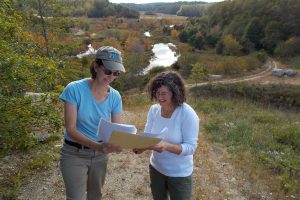 On Monday, October 17, 2016, the Society of Wetland Scientists signed a Memorandum of Cooperation with the Society for Ecological Restoration. In keeping with the mission of the two Societies, the President of SWS, Gillian Davies, and the Executive Director of SER, Bethanie Walder, signed the Memorandum while visiting a cranberry bog wetland restoration project at Tidmarsh Farms in Plymouth, MA, where they had the opportunity to tour the largest freshwater wetland restoration site (pictured below) in New England. Massachusetts Division of Ecological Restoration Director Tim Purinton and restoration site owners and project initiators Glorianna Davenport (M.I.T. Media Lab) and Evan Schulman generously hosted SWS and SER. Tidmarsh Farms is currently the site of a diverse set of research initiatives, including The Living Observatory.
On Monday, October 17, 2016, the Society of Wetland Scientists signed a Memorandum of Cooperation with the Society for Ecological Restoration. In keeping with the mission of the two Societies, the President of SWS, Gillian Davies, and the Executive Director of SER, Bethanie Walder, signed the Memorandum while visiting a cranberry bog wetland restoration project at Tidmarsh Farms in Plymouth, MA, where they had the opportunity to tour the largest freshwater wetland restoration site (pictured below) in New England. Massachusetts Division of Ecological Restoration Director Tim Purinton and restoration site owners and project initiators Glorianna Davenport (M.I.T. Media Lab) and Evan Schulman generously hosted SWS and SER. Tidmarsh Farms is currently the site of a diverse set of research initiatives, including The Living Observatory.
Tidmarsh Farms
Restoration efforts at the 250-acre, century old, cranberry bog began in 2010. This project is more than just a restoration effort. This project has also implemented new and innovative approaches to measuring complex ecological systems and methods to convey scientific information to the general public. Tidmarsh Farms established a diverse set of stakeholders for this project, and is now functioning as a research facility, living laboratory, plant nursery (the plants for the restoration effort were grown on-site) and dynamic, virtual website (partnership with the MIT Media Lab).
The Living Observatory is a particularly innovative approach that is being used at Tidmarsh Farms to research the processes by which wetlands respond to restoration actions (for example, whether they sequester or emit Carbon). Tidmarsh Farms is currently the site of a diverse set of research initiatives, whereby data collection is integrated into a dynamic, virtual website. Visitors to the virtual website can interact and experience the wetland in the field or over the Internet. For example, audio sensors have been placed throughout the farm, whereby someone wearing a specially designed headset can listen to wildlife that they can see from across the marsh, but are beyond earshot. In addition, fish that have been tagged in the field can be followed throughout the wetland system while navigating the restoration site in a virtual environment. There is also a plan to place an audio device on wood debris, so people can listen to the decomposition process as insects eat the logs.
